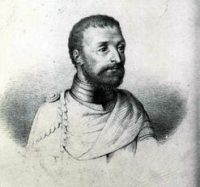[15 August: Victoria and Trinidad call at Cimbonbon (Banguey) on the south side of Balabac Strait, where they remain forty-two days repairing the ships and gathering provisions.]
[September: Carvalho is degraded to his former rank of flag pilot; Gómez de Espinosa is elected captain-general and captain of the Trinidad; Juan Sebastián de Elcano is elected captain of Victoria.]
Entre la punta norte de Burné y la isla de Cimbonbón, hacia los 8° 7′ de latitud septentrional, encontramos un puerto muy adecuado para recorrer nuestras naves, pero como carecíamos de muchas cosas necesarias a este fin, nos vimos obligados a emplear en esta operación cuarenta y dos días, trabajando todos lo mejor que podíamos, de una manera o de otra. Lo que más nos costaba era ir a buscar la madera en los bosques, porque todo el terreno estaba cubierto de zarzas y arbustos espinosos y nos hallábamos todos descalzos.
Hay en esta isla jabalíes muy grandes, habiendo nosotros muerto uno que pasaba a nado de una isla a otra; su cabeza, armada de colmillos muy gruesos, tenía dos palmos y medio de largo. Se encuentran también en ella cocodrilos, que habitan indistintamente en la tierra y en el mar; ostras, mariscos de toda especie y tortugas muy grandes.
Nosotros cogimos dos, la carne sola de una de las cuales pesaba veintiséis libras y la de la otra cuarenta y cuatro. Pescamos también un pez, cuya cabeza, parecida a la del cerdo, tenía dos cuernos, el cuerpo revestido de una sustancia ósea, y en el espinazo una especie de silla; pero no era muy grande.
Lo que he encontrado de más extraordinario son árboles cuyas hojas caídas tienen cierta vida. Estas hojas se parecen a las del moral, salvo que son menos largas; su pecíolo es corto y puntiagudo, y cerca de él, de uno y otro lado, dos pies: si se les toca se escapan, pero no echan sangre cuando se las revienta. Metí una de ellas en una caja y cuando abrí ésta después de nueve días, la hoja se paseaba por todo el interior: pienso que se mantienen del aire. [Parece que Pigafetta confundió un insecto con una hoja…]
[128] At the head of Borneo between it and an island called Cimbonbon, which lies in [a latitude of] eight degrees and seven minutes, is a perfect port for repairing ships; consequently, we entered it, but as we lacked many things for repairing the ships, we remained there for forty-two days.
During that time, each one of us laboured hard, one at one thing and one at another, but our greatest labour was to go barefoot into the woods for firewood. In that island there are wild boars, of which we killed one that was going by water from one island to another [by pursuing it] with the small boat; its head was two and one-half span long, and its teeth were large. There are large crocodiles there, both on land and sea, oysters and shellfish of various kinds; among the last named we found two, the flesh of one of which weighed twenty-six pounds, and the other forty-four. We caught a fish that had a head like that of a hog and two horns; its body consisted entirely of one bone, and on its back it resembled a saddle; and it was small. There are also found trees that produce leaves. When they fall they are living and walk about. Those leaves are very similar to those of the mulberry, but are not so long. On both sides near the stem they have two feet. The stem is short and pointed. They have no blood, but if one touches them they run away. I kept one of them for nine days in a box. When I opened the box, that leaf went round and round it. I believe those leaves live on nothing but air.
Sa ulo ng Burne, sa pagitan nitó at ng islang tinatawag na Cimbonbon, na matatagpuan sa [latitud na] walong digri at pitóng minuto, mayroong perpektong pantalan para sa pagkokompone ng mga barko. Dahil dito, pinasok namin ito; ngunit dahil kulang kami sa mga kagamitang pang-ayos ng mga barko, naantala kami doon nang apatnapu at dalawang araw. Sa loob ng panahong iyon, mabigat na nagtrabaho ang bawat isa sa amin, ang isa sa isang bagay at ang isa sa ibá. Subalit ang pinakapágod namin ay ang pagsuong sa gubat nang nakayapak para sa kahoy. Mayroong mga baboy-damo sa naturang isla, at pinatay namin ang isa na tumatawid sa tubig mula sa isang isla patúngo sa kabila [sa pamamagitan ng paghabol nitó] gámit ang maliit na bangka. Matatagpuan ang mga malalakíng buwaya, pareho sa lupa at sa dagat, at ibá’t ibáng uri ng talaba at shellfish. Nakahanap kami ng dalawang kabílang sa hulí, na ang laman ng isa ay may timbang na dalawampu at anim na pound, at ang kabila ay apatnapu at apat. Nakahúli kami ng isda na may ulong kahawig ng sa baboy at may dalawang sungay. Binubuo lámang ng isang buto ang katawan nitó, at sa likod nitó kahawig ng isang síya; at maliit ito. Matatagpuan din doon ang mga punòng gumagawa ng dahon na buháy kapag nalagas silá, at naglalakad. Katulad ng mga dahong iyon ang dahon ng moras, ngunit hindi singhabà. Sa parehong panig malápit sa tangkay, na maiksi at patusok, ay mayroon siláng dalawang paa. Wala siláng dugo, subalit kapag nahawakan ay tumatakbo palayo. Nagtago ako sa isang kahon ng isa sa kanilá sa loob ng siyam na araw. Pagbukás ko ng kahon, umikot-ikot sa loob ang dahong iyon. Sa tingin ko ay namumuhay lámang sa hangin ang mga naturang dahon.
